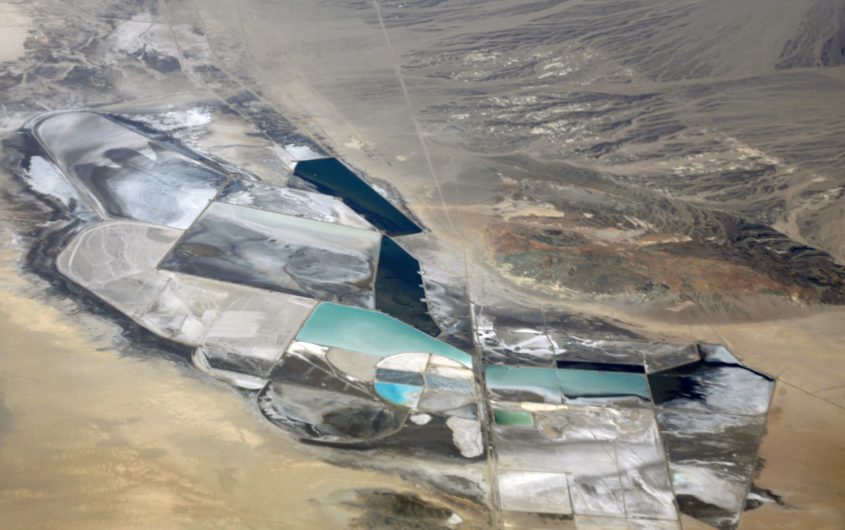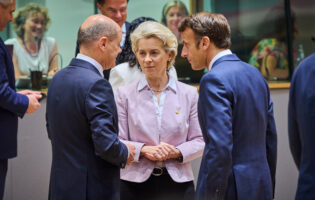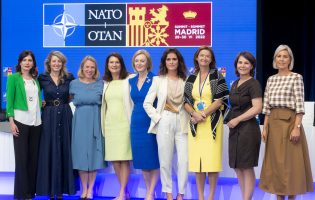
Doc Searls via Wikimedia
Changing Resource Needs for a Clean Energy Future: Transatlantic Implications – Part I

Kirsten Verclas
ORISE Science and Technology Policy Fellow
Kirsten Verclas is an ORISE Science and Technology Policy Fellow. Previously, she was a Program Manager in the International Department of the National Association of Regulatory Utility Commissioners (NARUC) working on regulatory partnerships in Africa under a NARUC-U.S. Agency for International Development (USAID) Cooperative Agreement. Before coming to NARUC, Ms. Verclas was a Senior Program Manager at the American Institute for Contemporary German Studies (AICGS) at Johns Hopkins University, where she managed the Institute’s grant projects. She initially joined AICGS as Executive Assistant in 2003 and started working in the Institute’s Research Program in 2008. Ms. Verclas has written extensively on energy and climate as well as security policy in the transatlantic context. She holds a BA in International Relations with a Minor in Economics from Franklin and Marshall College and an MA in International Relations with a concentration in Security Studies from The Elliott School at The George Washington University. She also earned an MS in Energy Policy and Climate from Johns Hopkins University in August 2013.
She is a 2017-2018 participant in AICGS’ project “A German-American Dialogue of the Next Generation: Global Responsibility, Joint Engagement,” sponsored by the Transatlantik-Programm der Bundesrepublik Deutschland aus Mitteln des European Recovery Program (ERP) des Bundesministeriums für Wirtschaft und Energie (BMWi).

Sonja Thielges
Institute for Advanced Sustainability Studies
Sonja Thielges is a Geoeconomics Non-Resident Fellow and was a DAAD/AICGS Research Fellow from mid-March to mid-May 2019 and explored foreign policy interests in Germany and the U.S. related to the countries’ energy transitions. In Germany, she is a senior research associate in the project “Pathways to Sustainable Energy” at the Institute for Advanced Sustainability Studies (IASS) in Potsdam. Sonja’s research interests include the international dimension of the energy transition, foreign energy policy, the G20 energy agenda, as well as U.S. energy and climate policy. Her research has been published in studies, policy papers, online blogs, and academic publications.
Prior to IASS, Sonja worked in the Americas Division at the German Institute for International and Security Affairs (SWP) in Berlin, focusing on U.S. climate and energy policy. She was a visiting researcher at the University of Michigan’s Center for Local, State, and Urban Policy in Ann Arbor in 2014 and previously also worked on projects at the Environmental Policy Research Centre (FFU), the Institut für Europäische Politik (IEP) Berlin, and the Centre International de Formation Européenne (CIFE). In 2017/2018, Sonja was a participant in the AICGS project “A German-American Dialogue of the Next Generation: Global Responsibility, Joint Engagement,” sponsored by the Transatlantik-Programm der Bundesrepublik Deutschland aus Mitteln des European Recovery Program (ERP) des Bundesministeriums für Wirtschaft und Energie (BMWi). She completed an M.A. in North American Studies, Political Science, and Modern History at Freie Universität Berlin and Indiana University Bloomington and holds a PhD in political science from Freie Universität Berlin. Her PhD thesis studied climate policy discourses in the U.S. Rust Belt states.
Critical Materials for a Clean Energy Transition: Rare Earths and Strategic Resources
The transformation toward cleaner energy sources entails a demand for resources that are required in clean energy technologies. The production of magnets used in wind turbines, for instance, requires neodymium and dysprosium—rare earths, recovered through an energy-intensive mining process. Electric vehicles are run by lithium-ion batteries, which are also used in smartphones and laptops. Key ingredients of these batteries are cobalt and lithium, which the U.S. Geological Service characterizes as critical or strategic resources because there is a high likelihood for costly supply interruptions.
Most of the resources required for clean energy technologies are mined abroad—a shared challenge the transatlantic partners face. Often, few countries dominate the market for critical materials, including countries with unstable regimes, questionable human right records, and little regard for environmentally sustainable mining processes. The Democratic Republic of Congo (DRC), for instance, is a politically highly unstable regime that is responsible for the production of some 60 percent of cobalt, which is used in batteries. Cobalt has experienced a 90 percent price jump within one single year, which underlines the challenges this dependence on a single, unstable supplying country poses. Lithium, another component of batteries, has more suppliers. Australia and Chile produce roughly 40 percent and Argentina another 10 percent. Nevertheless, a shortage in supply in 2015 doubled the price of lithium. Rare earths necessary for the production of magnets are mainly mined in China, which produces 95 percent of global supply, also creating a market monopoly. With China’s own demand for clean energy technologies growing exponentially in recent years, this concentration poses high risks to global markets.
The deep sea potentially holds vast supplies of resources such as copper, lithium, and rare earths. With growing demand for critical materials and increasing prices for some resources, deep sea mining may become a competitive source of materials. However, the effects of deep sea mining on ecosystems are largely not understood yet and potentially devastating, thus posing a set of new environmental challenges.
Transatlantic Responses to Economic, Environmental, and Social Challenges of Critical Materials
The challenge at hand is thus not necessarily a scarcity of resources. Rather, high resource consumption as well as import dependence have social, economic, and environmental implications highly relevant not only for the countries’ economies, but also for meeting the UN Sustainable Development Goals (SDGs) as well as climate protection goals under the Paris Climate Agreement. Price spikes can make the energy transition expensive, challenging the social sustainability of clean energy at home. Both countries have thus introduced strategies to address these challenges, which are remarkably similar and offer many opportunities for cooperation.
Germany’s Resource Strategy
Germany established a resource strategy in 2010 as a response to growing concerns about supply security. In its resource strategy, the German government pursues a mix of measures to ensure resource availability, competitiveness, and sustainability, leaving it, however, mainly up to industry to organize supply of resources. Among the government activities are resource partnerships with key supplying countries as well as R&D programs to promote efficiency and recycling. In 2010, the German government established the German Mineral Resources Agency (DERA) under the Ministry of Economic Affairs and Energy as a response to information and consultancy needs created through the energy transition and other technological developments. In 2011, Germany set up the Helmholtz Institute Freiberg for Resource Technology in order to promote research on raw material efficiency and recycling. In addition, the government offers loan guarantees for investors in international resource projects and takes part in various international activities such as the Extractive Industries Transparency Initiative (EITI) to foster free trade in resources and improve market transparency.
The U.S. Critical Material Strategy
The U.S. Department of Energy developed its first Critical Material Strategy in 2010 to understand and address challenges regarding minerals and rare earths needed in energy technologies. Additionally, the Department also supports the Critical Material Institute (CMI) at the Ames National Laboratory, which is focused on developing substitutes and more efficient uses of dysprosium, terbium, europium, neodymium, and yttrium, as well as lithium and tellurium. The CMI also researches the diversification of supply and ways to forecast materials that might become critical in the future. Under the Obama administration, the U.S. and EU coordinated with Japan on how to ensure the availability of critical materials through a series of joint annual conferences. In December 2017, President Trump signed the Executive Order on a Federal Strategy to Ensure Secure and Reliable Supplies of Critical Minerals. The Executive Order follows an assessment by the U.S. Geological Survey of the U.S. critical materials published in the same month and calls for the development of a strategy to reduce the nation’s dependence on the critical materials by summer 2018.
Part II of this article explains how the U.S. and Germany could benefit strategically from a stronger cooperation on critical materials.








